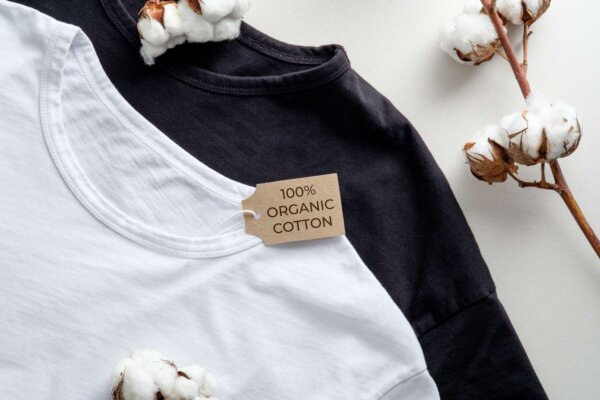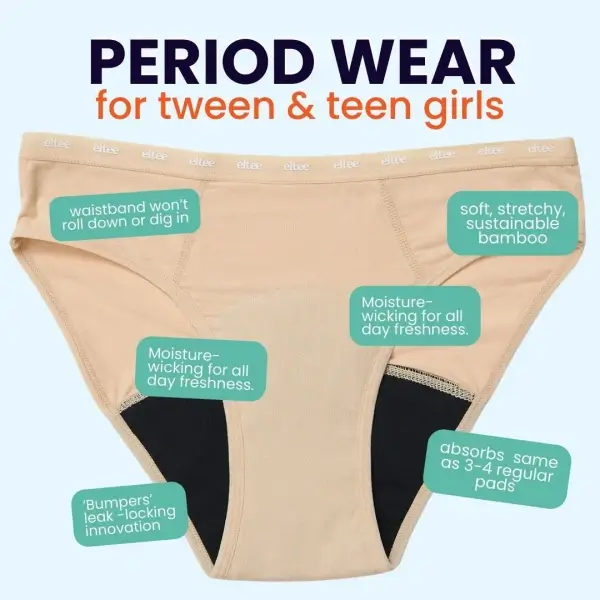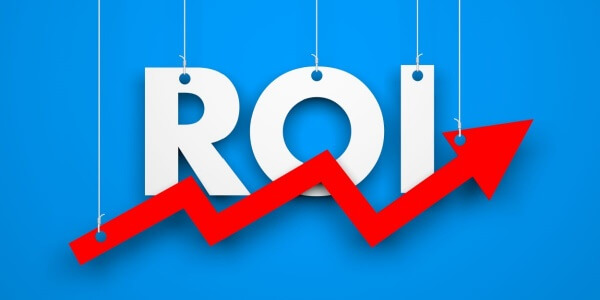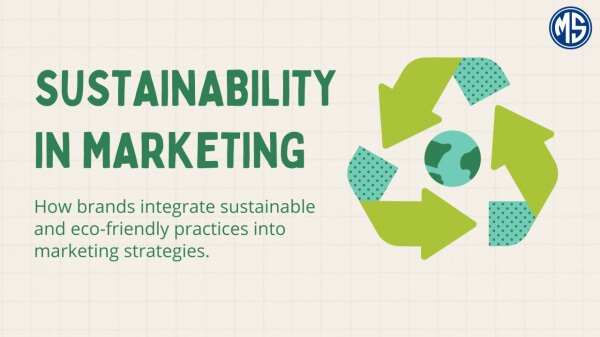El caso de negocios para ropa interior de período sostenible: satisfacer la demanda del consumidor & ¿Mejora del valor de la marca?
Las preocupaciones ambientales están impulsando cada vez más las decisiones de compra de los consumidores. Las marcas que ignoran la sostenibilidad del riesgo de perder la participación de mercado a competidores más ecológicos, particularmente en categorías de ropa íntimas como la ropa interior del período.
La ropa interior del período sostenible representa tanto un imperativo ambiental como una oportunidad de negocio. El 73% de los consumidores están dispuestos a pagar más por los productos sostenibles, y la naturaleza reutilizable de la ropa interior de época ya lo posiciona como una alternativa ecológica a los desechables, ahorrando cientos de productos de un solo uso de vertederos durante la vida útil de cada prenda.

Al tener, hemos adoptado la sostenibilidad en nuestra fabricación de ropa interior de época, ofreciendo opciones de algodón orgánico, materiales reciclados y soluciones de embalaje ecológicas. Nuestra experiencia produciendo más de 2 millones de unidades anualmente ha demostrado que la sostenibilidad no solo es buena para el planeta, es bueno para los negocios. Permítanme compartir lo que hemos aprendido sobre el caso comercial convincente para la ropa interior de período sostenible.
¿Por qué la sostenibilidad se está convirtiendo en un imperativo del mercado?
Las preferencias del consumidor están cambiando drásticamente hacia opciones sostenibles. Las marcas que no reconocen este riesgo de tendencia se obsoletan a medida que las alternativas ecológicas capturan la cuota de mercado.
El 73% de los consumidores globales dicen que definitivamente o probablemente cambiarían sus hábitos de consumo para reducir el impacto ambiental, y este porcentaje aumenta al 83% entre los millennials. En la categoría de productos menstruales específicamente, el 76% de los menstruadores expresan preocupación por el impacto ambiental de los productos de período desechable.

Cuando comenzamos la ropa interior del período de fabricación al tener, la sostenibilidad se consideró un punto de venta de nicho. Hoy, se ha convertido en una expectativa convencional, particularmente en esta categoría. He aquí por qué la sostenibilidad se ha convertido en un imperativo del mercado:
Valores de consumo cambiantes
La investigación de mercado reciente revela cambios dramáticos en las prioridades del consumidor:
| Tendencia del consumidor | Porcentaje | Implicación comercial |
|---|---|---|
| Dispuesto a pagar más por productos sostenibles | 73% | Oportunidad de precios premium |
| Considere el impacto ambiental importante en las decisiones de compra | 78% | Sostenibilidad como ventaja competitiva |
| Busque activamente marcas con fuertes valores ambientales | 64% | Oportunidad de lealtad de marca |
| Han cambiado de marca en función de las preocupaciones ambientales | 37% | Riesgo de pérdida del cliente si no aborda la sostenibilidad |
Diferencias generacionales
Las preferencias de sostenibilidad varían significativamente según la generación:
- Gen Z (18-24): El 90% cree que las empresas deben abordar los problemas ambientales
- Millennials (25-40): El 83% dice que las preocupaciones ambientales afectan sus decisiones de compra
- Gen X (41-56): 66% dispuesto a pagar más por productos sostenibles
- Baby Boomers (57-75): El 57% considere la sostenibilidad en las decisiones de compra
Con generaciones más jóvenes que representan el mercado principal para la ropa interior de época, sus preferencias de sostenibilidad más fuertes son particularmente relevantes para esta categoría.
Preocupaciones específicas del producto menstrual
La industria de productos menstruales desechables enfrenta un escrutinio particular:
- Cada menstruador utiliza aproximadamente 11,000 productos de período desechable en su vida
- Las almohadillas desechables pueden contener hasta 90% de plástico y tomar 500-800 años para descomponerse
- Los aplicadores de tampones se encuentran entre los contaminantes plásticos más comunes que se encuentran en las playas
Estas preocupaciones han creado una importante oportunidad de mercado para alternativas reutilizables como la ropa interior de época, que puede reemplazar a cientos de productos desechables durante su vida.
Para una descripción completa del mercado de ropa interior de época y las tendencias del consumidor, visite nuestro análisis detallado: Comprender el mercado de ropa interior del período: tendencias, demografía & Oportunidades para compradores B2B.
¿Qué hace que la ropa interior del período sea inherentemente sostenible?
La ropa interior de época ya tiene fuertes credenciales de sostenibilidad en comparación con las alternativas desechables. Comprender estas ventajas inherentes ayuda a las marcas de manera efectiva a comunicar sus beneficios ambientales.
Un solo par de ropa interior de período puede reemplazar aproximadamente 100-200 almohadillas o tampones desechables durante su vida, lo que reduce significativamente los desechos. Incluso la ropa interior estándar del período reduce el impacto ambiental en un 60-80% en comparación con los desechables, mientras que las versiones sostenibles mejoradas que utilizan materiales orgánicos o reciclados pueden lograr una reducción de impacto del 85-90%.

Al tener, ayudamos a nuestros socios a cuantificar y comunicar los beneficios ambientales de sus productos de ropa interior de época. Esto es lo que hace que la ropa interior del período sea inherentemente más sostenible que las alternativas desechables:
Beneficios de reducción de desechos
La ventaja de sostenibilidad más obvia es la reducción de residuos:
-
Comparación de residuos de por vida:
- Desechables: 5,000-15,000 productos por menstruador
- Ropa interior de período: 20-30 pares (reemplazados cada 2-3 años)
-
Impacto del vertedero:
- Las almohadillas/tampones desechables tardan 500-800 años en descomponerse
- Los componentes de ropa interior de época generalmente se descomponen dentro de 1 a 100 años, dependiendo de los materiales
-
Reducción de plástico:
- Las almohadillas desechables contienen hasta un 90% de materiales plásticos
- La ropa interior de época se puede hacer con contenido mínimo o sin plástico
Conservación de recursos
Más allá de la reducción de residuos, la ropa interior del período conserva los recursos:
-
Uso de agua: Si bien la ropa interior del período requiere lavado, la huella de agua total sigue siendo menor que la producción desechable cuando se considera sobre el ciclo de vida del producto
-
Consumo de energía: La energía requerida para producir un par de ropa interior de período se compensa después de aproximadamente 6-8 usos en comparación con alternativas desechables
-
Eficiencia de materia prima: Los materiales en un par de ropa interior de período producirían solo 5-10 almohadillas desechables
Reducción de la huella de carbono
Las evaluaciones del ciclo de vida muestran ventajas significativas de carbono:
-
Comparación de carbono:
- Desechables: aproximadamente 5-7 kg CO2E por año
- Ropa interior de período: aproximadamente 2-3 kg de CO2E por año (incluido el lavado)
-
Impacto del transporte: El volumen de envío reducido y la frecuencia disminuyen significativamente las emisiones de transporte
Comunicar beneficios inherentes
Incluso sin materiales sostenibles adicionales, las marcas pueden resaltar estos beneficios inherentes:
- "One pair replaces 100+ disposable products"
- "60% lower carbon footprint than disposables"
- "Diverts pounds of waste from landfills"
- "Reduces plastic pollution in oceans and waterways"
Para obtener información detallada sobre materiales y tecnología de ropa interior de época, visite nuestra guía integral: Tecnología de ropa interior de época & Materiales: una guía del comprador para la absorción, telas & A prueba de fugas.
¿Cómo puede mejorar la sostenibilidad de la ropa interior del período?
Si bien la ropa interior del período es inherentemente más sostenible que los desechables, existen numerosas oportunidades para mejorar aún más sus credenciales ambientales y crear una diferenciación significativa.
La sostenibilidad mejorada en la ropa interior de época se puede lograr a través de la selección de materiales (algodón orgánico, poliéster reciclado, componentes biodegradables), mejoras de fabricación (conservación del agua, energía renovable, técnicas de desechos cero) e innovaciones de embalaje (opciones sin plástico, reciclables o compostables). Cada mejora crea ventajas de marketing adicionales y atrae a diferentes segmentos de consumo.

Al tener, hemos desarrollado múltiples enfoques para mejorar la sostenibilidad de la ropa interior del período. Estas son las estrategias más efectivas:
Opciones de material sostenible
Alternativas de tela facial
-
Algodón orgánico
- Beneficio ambiental: 91% menos uso de agua, sin pesticidas
- Atractivo del consumidor: Natural, sin químicos, suave contra la piel
- Certificación: Gots (estándar de textil orgánico global)
- Impacto en el costo: +15-25% sobre algodón convencional
-
Poliéster reciclado
- Beneficio ambiental: 30-50% menos uso de energía, desvía desechos plásticos
- Atractivo del consumidor: Desvía botellas de plástico de los vertederos
- Certificación: GRS (estándar reciclado global)
- Impacto en el costo: +5-15% sobre el poliéster virgen
-
Bambú lyocell
- Beneficio ambiental: Recurso renovable rápidamente, procesamiento de circuito cerrado
- Atractivo del consumidor: Propiedades antimicrobianas naturales excepcionalmente suaves
- Certificación: FSC (Consejo de Administración Forestal)
- Impacto en el costo: +10-20% sobre telas convencionales
Innovaciones de capa absorbente
-
Capas absorbentes de algodón orgánico
- Beneficio ambiental: Biodegradable, sin productos químicos
- Consideración de rendimiento: Un poco más voluminoso que las alternativas sintéticas
- Impacto en el costo: +15-25% sobre materiales absorbentes sintéticos
-
Microfibra reciclada
- Beneficio ambiental: Desvía los desechos textiles, reduce el uso del material virgen
- Consideración de rendimiento: Mantiene el rendimiento de los materiales virgen
- Impacto en el costo: +5-15% sobre microfibra estándar
Alternativas de barrera a prueba de fugas
-
TPU basada en biografía
- Beneficio ambiental: Dependencia del petróleo reducida parcialmente derivada de plantas
- Consideración de rendimiento: Comparable a la TPU convencional
- Impacto en el costo: +20-30% sobre barreras estándar
-
Barreras biodegradables
- Beneficio ambiental: Impacto reducido del final de la vida
- Consideración de rendimiento: Requiere un diseño cuidadoso para mantener la durabilidad
- Impacto en el costo: +25-40% sobre barreras estándar
Procesos de fabricación sostenibles
Conservación del agua
-
Sistemas de agua de circuito cerrado
- Beneficio ambiental: 80-90% Reducción de agua
- Costo de implementación: Alta inversión inicial, ahorros a largo plazo
- Valor de marketing: Historia de conservación de agua fuerte
-
Tinte de agua baja
- Beneficio ambiental: 50-60% Reducción de agua
- Costo de implementación: Inversión moderada
- Valor de marketing: Ahorros de agua cuantificables por prenda
Eficiencia energética
-
Fabricación de energía renovable
- Beneficio ambiental: Huella de carbono reducido
- Costo de implementación: Varía según la instalación y la región
- Valor de marketing: Reclamos de reducción de carbono
-
Equipo de eficiencia energética
- Beneficio ambiental: 20-40% Reducción de energía
- Costo de implementación: Inversión moderada, ahorros operativos
- Valor de marketing: Emisiones reducidas por producto
Reducción de desechos
-
Corte de patrón de cero desembolsos
- Beneficio ambiental: Minimiza los desechos de tela
- Costo de implementación: Requiere adaptación de diseño
- Valor de marketing: Historia de reducción de desechos tangibles
-
Programas de reciclaje de chatarra
- Beneficio ambiental: Desvía los desechos de fabricación del vertedero
- Costo de implementación: Bajo a moderado
- Valor de marketing: Narrativa de producción de circuito cerrado
Soluciones de embalaje sostenibles
Opciones sin plástico
-
Embalaje de papel reciclado
- Beneficio ambiental: Elimina el plástico, usa desechos posteriores al consumo
- Impacto en el costo: Neutral a ligeramente más alto que el plástico
- Atractivo del consumidor: Compromiso de sostenibilidad visible
-
Bolsas de algodón orgánicas
- Beneficio ambiental: Reutilizable, biodegradable
- Impacto en el costo: Más alto que el embalaje convencional
- Atractivo del consumidor: Presentación premium, digna de un regalo
Embalaje minimalista
-
Enfoque material reducido
- Beneficio ambiental: Menos desechos generales
- Impacto en el costo: Potencial de ahorro de costos
- Atractivo del consumidor: Se alinea con los valores del consumidor de desechos cero
-
Embalaje multipropósito
- Beneficio ambiental: Vida útil extendida
- Impacto en el costo: Varía por diseño
- Atractivo del consumidor: Percepción de valor agregado
Para obtener orientación sobre la construcción de una línea de ropa interior de período sostenible completo, visite nuestro recurso en Curación de su colección: una guía B2B para estilos de ropa interior de época, absorbencias & Opciones de material.
¿Cuál es el ROI en ropa interior de período sostenible?
Muchas empresas dudan en invertir en sostenibilidad debido a las preocupaciones sobre los costos y los rendimientos. Comprender el caso comercial completo ayuda a justificar estas inversiones.
El retorno de la inversión para la ropa interior de período sostenible se produce a través de múltiples canales: potencial de precios premium (10-30% de puntos de precio más altos), mayor lealtad del cliente (tasas de retención 23% más altas para marcas sostenibles), reputación de marca mejorada, ventajas de colocación minorista y riesgo reducido de futuros problemas de cumplimiento regulatorio.

Al tener, hemos visto de primera mano cómo las inversiones de sostenibilidad ofrecen rendimientos comerciales tangibles. Aquí está el caso comercial integral:
Beneficios financieros
Potencial de fijación de precios premium
La investigación de mercado muestra que los consumidores pagarán más por los productos sostenibles:
- El 73% pagará al menos un 10% más por opciones sostenibles
- El 35% pagará un 25% o más por productos con sólidas credenciales ambientales
- En ropa interior de período específicamente, las opciones sostenibles comandan 15-30% primas de precio
Mayor volumen de ventas
La sostenibilidad impulsa las decisiones de compra:
- El 78% de los consumidores es más probable que compren productos claramente marcados como ecológicos.
- Las marcas de ropa interior de período sostenible generalmente ven tasas de conversión 20-35% más altas
- Los minoristas informan 15-25% más altas tarifas de venta para productos menstruales sostenibles
Lealtad mejorada del cliente
La sostenibilidad genera relaciones con los clientes más fuertes:
- Las marcas con credenciales de sostenibilidad sólidas disfrutan de una retención de clientes 23% más alta
- Es más probable que el 43% de los consumidores recomiende marcas sostenibles a amigos
- El valor del cliente de por vida aumenta en aproximadamente un 20% para productos sostenibles
Mejora del valor de la marca
Beneficios de reputación
La sostenibilidad fortalece la percepción general de la marca:
- El 66% de los consumidores (y el 73% de los millennials) tienen una imagen más positiva de las marcas con compromisos de sostenibilidad comprobados
- La cobertura de los medios es 3 veces más probable para las marcas con historias de sostenibilidad auténticas
- Las tasas de participación en las redes sociales son un 40% más altas para el contenido de productos sostenible
Diferenciación competitiva
En el mercado de ropa interior de época cada vez más llena:
- La sostenibilidad crea una diferenciación significativa más allá de la funcionalidad básica
- El 57% de los consumidores consideran el impacto ambiental al elegir entre productos similares
- Las credenciales de sostenibilidad ayudan a evitar presiones de precios de productos básicos
Ventajas de colocación minorista
Los principales minoristas priorizan cada vez más productos sostenibles:
- Muchos minoristas han establecido requisitos de sostenibilidad para nuevos proveedores
- La colocación minorista premium a menudo se asigna a opciones sostenibles
- Algunos minoristas ofrecen soporte de marketing específicamente para productos sostenibles.
Mitigación de riesgos
Cumplimiento regulatorio
La adopción de sostenibilidad proactiva reduce los riesgos futuros:
- Las regulaciones ambientales se están volviendo más estrictas a nivel mundial
- La adopción temprana evita cambios forzados costosos más tarde
- Algunos mercados están implementando leyes de responsabilidad del productor extendido
Protección contra la reacción de consumo
La sostenibilidad protege contra la publicidad negativa:
- Las marcas sin compromisos ambientales enfrentan un escrutinio creciente
- Las redes sociales amplifican las preocupaciones ambientales rápidamente
- Las acusaciones de lavado verde pueden causar daños significativos en la marca
Marco de cálculo de ROI
Al evaluar las inversiones de sostenibilidad, considere este marco:
| Categoría de inversión | Aumento de costos típico | Rendimiento potencial | Período de recuperación |
|---|---|---|---|
| Materiales sostenibles | 10-25% | 15-30% Precio Premio | Inmediato a 6 meses |
| Fabricación Sostenible | 5-15% inicialmente | 10-20% aumentó las ventas + ahorros operativos | 1-3 años |
| Embalaje sostenible | 5-20% | 10-15% de mejora de conversión | 6-12 meses |
| Certificación de sostenibilidad | $ 2,000-10,000 anuales | 15-25% Aumento de la colocación del minorista | 6-18 meses |
Para obtener información detallada sobre estrategias de precios y márgenes de beneficio, explore nuestro análisis: Maximización de su ROI: Precios al por mayor de ropa interior de época, márgenes minoristas & Análisis de rentabilidad.
¿Cómo se comercializa efectivamente la ropa interior del período sostenible?
Crear productos sostenibles es solo la mitad de la ecuación. Muchas marcas no pueden comunicar efectivamente sus beneficios ambientales, perdiendo la oportunidad de capturar el valor total de sus inversiones de sostenibilidad.
El marketing efectivo de ropa interior sostenible combina reclamos ambientales cuantificables (número de desechables reemplazados, desechos plásticos evitados), certificaciones relevantes (GOTS, Oeko-Tex, GRS), comunicación transparente sobre el viaje de sostenibilidad y la conexión emocional con los valores ambientales, todo mientras evita el lavado verde a través de mensajes honestos, específicos y verificables.

Al tener, ayudamos a nuestros socios a desarrollar mensajes de sostenibilidad auténticos que resuenen con los consumidores. Estos son los enfoques más efectivos:
Reclamos ambientales cuantificables
Los beneficios específicos y medibles son más convincentes que las declaraciones vagas:
- Reducción de desechos: "One pair replaces 100+ disposable products"
- Evitación de plástico: "Prevents 5-7 pounds of plastic waste annually"
- Conservación del agua: "Saves X gallons of water compared to disposables"
- Reducción de carbono: "60% lower carbon footprint than disposable alternatives"
Apalancamiento de certificación
Certificaciones de terceros Credibilidad de compilación:
- Certificaciones de material: Gots (orgánico), GRS (contenido reciclado), oeko-tex (seguridad)
- Certificaciones de proceso: Bluesign® (fabricación ambiental), ISO 14001 (gestión ambiental)
- Certificaciones sociales: Comercio justo, envoltura (fabricación ética)
Transparencia sobre el viaje
Comunicación auténtica sobre el progreso de la sostenibilidad:
- Logros actuales: Comunicar claramente lo que ha logrado
- Objetivos futuros: Comparta su hoja de ruta de sostenibilidad
- Desafíos: Reconocer las áreas que aún se están mejorando
- Contenido educativo: Ayudar a los consumidores a comprender los impactos ambientales
Conexión emocional
Enlace los beneficios ambientales a los valores personales:
- Impacto personal: Cómo la elección de una persona hace la diferencia
- Generaciones futuras: Protección del planeta para niños
- Mundo natural: Preservar ecosistemas y vida silvestre
- Beneficio comunitario: Apoyo a las comunidades sostenibles
Evitar el lavado verde
Mantener la credibilidad a través de una comunicación honesta:
- Ser específico: Avoid vague terms like "eco-friendly" sin explicación
- Ser honesto: No exagere los beneficios ambientales
- Ser verificable: Haga afirmaciones que puedan ser justificadas
- Ser integral: Dirija el ciclo de vida completo del producto
Canales de comercialización para la sostenibilidad
Los diferentes canales requieren mensajes de sostenibilidad personalizados:
Envasado de productos
- Iconos/símbolos de sostenibilidad claros
- Declaraciones concisas de beneficios ambientales
- Logotipos de certificación se muestran prominentemente
- Los códigos QR que vinculan con información detallada de sostenibilidad
Contenido del sitio web
- Página de sostenibilidad dedicada con información integral
- Explicaciones de material y proceso
- Calculadoras de impacto ambiental
- Contenido detrás de escena que muestra prácticas sostenibles
Redes sociales
- Narración visual de beneficios ambientales
- Contenido generado por el usuario que muestra opciones sostenibles
- Infografías educativas sobre el impacto ambiental
- Celebraciones de hitos de sostenibilidad
Marketing minorista
- Capacitación del personal sobre características de sostenibilidad
- Muestras en la tienda destacando los beneficios ambientales
- Gráficos de comparación que muestran beneficios versus desechables
- Eventos promocionales centrados en la sostenibilidad
Para obtener información sobre los requisitos de cumplimiento y certificación que respalden las reclamaciones de sostenibilidad, visite nuestra guía sobre Abastecimiento con confianza: navegación de cumplimiento, certificaciones & Normas de fábrica.
Conclusión
El caso comercial para la ropa interior de período sostenible es convincente y multifacética. Más allá de satisfacer la creciente demanda de los consumidores de productos ambientalmente responsables, las iniciativas de sostenibilidad ofrecen beneficios comerciales tangibles a través de oportunidades de precios premium, mayor lealtad del cliente, valor de marca mejorado y mitigación de riesgos.
Para obtener una descripción completa de toda la categoría de ropa interior del período, incluidas las consideraciones de fabricación y las oportunidades de asociación, visite nuestra Guía Ultimate B2B para el abastecimiento & Ropa interior del período de venta.
Al tener, estamos comprometidos a apoyar a nuestros socios en el desarrollo de ropa interior de período verdaderamente sostenible que brinde beneficios ambientales y comerciales. Al adoptar la sostenibilidad como una estrategia comercial central en lugar de una ocurrencia posterior de marketing, las marcas pueden posicionarse para el éxito a largo plazo en este mercado en rápida evolución.
Preguntas frecuentes (preguntas frecuentes)
¿Cuál es la característica de sostenibilidad más importante para los consumidores de ropa interior de época?
Si bien las preferencias varían según el segmento, la investigación muestra que la reducción de residuos (reemplazo de desechables) es el beneficio de sostenibilidad más valorado universalmente, seguido de contenido plástico reducido y materiales orgánicos/naturales.
¿Cuánto más están los consumidores dispuestos a pagar la ropa interior de período sostenible?
La investigación de mercado indica que el 73% de los consumidores pagarán al menos un 10% más por opciones sostenibles, mientras que el 35% pagará primas del 25% o más por los productos con sólidas credenciales ambientales.
¿Qué certificaciones de sostenibilidad son más valiosas para la ropa interior de época?
OEKO-TEX Standard 100 proporciona credibilidad de seguridad esencial, mientras que la certificación GOTS es más valiosa para reclamos orgánicos y certificación GRS para contenido reciclado. Las certificaciones de cumplimiento social como Wrap o Fair Trade agregan credenciales de fabricación ética.
¿Cómo pueden las pequeñas marcas competir con las grandes empresas con la sostenibilidad?
Las marcas pequeñas a menudo pueden implementar iniciativas de sostenibilidad de manera más rápida y auténtica que las grandes corporaciones. Concéntrese en la comunicación transparente, los beneficios ambientales específicos y la creación de conexiones genuinas con los consumidores con mentalidad de sostenibilidad.
¿Es mejor centrarse en materiales sostenibles o fabricación sostenible?
Ambos son importantes, pero los materiales sostenibles generalmente tienen una visibilidad y un impacto de marketing más inmediato del consumidor. Sin embargo, un enfoque integral que aborda los materiales y los procesos de fabricación crea el posicionamiento de sostenibilidad más fuerte.
¿Cómo evito las acusaciones de lavado verde cuando comercializa ropa interior de período sostenible?
Sea específico sobre las afirmaciones ambientales, proporcione evidencia y certificaciones para respaldarlos, reconocer las áreas que aún se mejoran y centrarse en el progreso en lugar de la perfección. La transparencia sobre su viaje de sostenibilidad genera credibilidad.
Obtenga una cotización gratuita para su período de proyectos de bragas
